|
|
|
Sort Order |
|
|
|
Items / Page
|
|
|
|
|
|
|
| Srl | Item |
| 1 |
ID:
186335
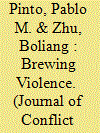

|
|
|
|
|
| Summary/Abstract |
Two prominent features in current world affairs are the unprecedented level of global economic integration and the growing incidence of intrastate violence. We develop and test a novel argument linking global integration through foreign investment to intrastate armed conflict. The presence of multinational corporations in developing countries can cause market concentration, resulting in high rents. Disputes between governments and would-be challengers over the appropriation of these rents are likely to turn violent, increasing the incidence of armed conflict. State capacity mitigates this positive association between foreign investment and intrastate war. Strong states have the capacity to deter rebellions, address citizens’ demands through institutionalized mechanisms, and credibly commit to the peaceful resolution of conflicts. Using data from developing countries for over four decades and addressing potential endogeneity and selection biases, we find strong support for our hypotheses. Our findings have important implications for understanding the link between economic interdependence and conflict.
|
|
|
|
|
|
|
|
|
|
|
|
|
|
|
|
| 2 |
ID:
100394


|
|
|
|
|
| Publication |
2010.
|
| Summary/Abstract |
Most studies of Hindu-Muslim riots in India have tended to emphasize the effects of social, cultural, or political factors on the occurrence of ethnic violence. In this article, the authors focus on the relationship between economic conditions and riots. Specifically, this article examines the effect of economic growth on the outbreak of Hindu-Muslim riots in 15 Indian states between 1982 and 1995. Controlling for other factors, the authors find that just a 1% increase in the growth rate decreases the expected number of riots by over 5%. While short-term changes in growth influence the occurrence of riots, this study finds no evidence of a relationship between the levels of wealth in a state and the incidence of ethnic riots. Moreover, by including state fixed effects, the authors determine that the negative relationship found between economic growth and riots is driven primarily by the relationship between growth and riots within a state over time rather than across states. These results are robust to controlling for a number of other factors such as economic inequality, demographic variables, political competition, temporal lags, spillover effects from adjacent states, and year effects. Finally, to address potential concerns that economic growth could be a consequence rather than a cause of violence or that other unobserved factors could confound the relationship between economic growth and the occurrence of Hindu-Muslim riots, the authors also employ instrumental variables (IV) estimation, using percentage change in rainfall as an instrument for growth. The results with IV estimation are similar to the results with non-IV estimation in terms of sign and significance, indicating that the negative effect of economic growth on riots is not due to reverse causality or omitted variables bias.
|
|
|
|
|
|
|
|
|
|
|
|
|
|
|
|
| 3 |
ID:
089548
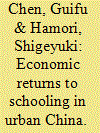

|
|
|
|
|
| Publication |
2009.
|
| Summary/Abstract |
This paper examines economic returns to schooling in urban China using ordinary least square (OLS) and instrumental variable (IV) methodologies. First, we find that OLS estimates of the returns to education are lower in China than in other transition economies, whereas IV estimates are higher in China. Second, we find that OLS, a method for estimating the returns to education without control for endogeneity bias, may underestimate the true rates of return for men. In addition, if we do not control for endogeneity bias and the sample selection bias, we may further underestimate the true rates of return for women. Finally, we find that OLS estimates of the returns to education for men are slightly higher than for women. The IV estimates for women are higher than those for men, and this difference increases after correcting for selectivity biases.
|
|
|
|
|
|
|
|
|
|
|
|
|
|
|
|
| 4 |
ID:
137696
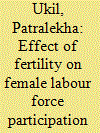

|
|
|
|
|
| Summary/Abstract |
This article aims to estimate the causal effect of fertility on the labour force participation of British women. In order to account for the possible endogeneity of fertility variables, the sex composition of the two previous children of a mother has been used as an instrument for fertility. The Two-stage Residual Inclusion (2SRI) estimation method is used on a relatively new British data set—‘Understanding Society’. The results suggest that fertility is indeed endogenous to the labour force participation decisions of women in the sample, and that not accounting for the endogeneity of the fertility variable leads to an exaggeration of the negative effect of fertility on female labour force participation. Important policy recommendations are drawn from the results.
JEL Classification: J13, J22
|
|
|
|
|
|
|
|
|
|
|
|
|
|
|
|
| 5 |
ID:
179683
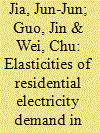

|
|
|
|
|
| Summary/Abstract |
China has implemented the residential increasing-block electricity pricing (IBEP) policy since the second half of 2012, which is considered the most effective economic instrument in improving residential energy efficiency. Price and income elasticity are two fundamental parameters to guide both scholars and policy-makers in assessing whether and to what extend Chinese households respond to the policy. However, it presents the challenge of simultaneous determination of marginal price and electricity consumption; further, it is less examined from an empirical perspective due to the absence of micro-level data. To fill this gap, this study estimates price and income elasticity by establishing two instrumental variables, based on a unique dataset from the Chinese Residential Energy Consumption Survey 2014. Results show that the residential demand for electricity is price inelastic and that electricity is an essential commodity for households in the short run. It also shows great urban-rural disparity and regional heterogeneity of household electricity consumption behavior regarding short-run income elasticity. The estimated parameters of short-run price and income elasticities provide a valuable reference for policy-making regarding both a nationwide uniform and a differential regional perspective.
|
|
|
|
|
|
|
|
|
|
|
|
|
|
|
|
| 6 |
ID:
166362
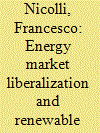

|
|
|
|
|
| Summary/Abstract |
This paper investigates the effect of energy liberalization, compared to other drivers, on policies that support renewable energy in a long panel of OECD countries. We estimate this effect by accounting for the endogeneity of liberalization related to joint decisions within a country’s energy strategy. Using regulation in other industries as instruments, we find that energy liberalization increases public support for renewable energy. The effect of liberalization is the second largest after the effect of per-capita income and is mostly driven by reductions in entry barriers, while the effect of privatization is unclear. This finding suggests that a reduction in the monopolistic power of state-owned utilities has a positive effect on renewable energy policies when various types of actors are ensured access to the grid instead of it being provided to only a few large private firms.
|
|
|
|
|
|
|
|
|
|
|
|
|
|
|
|
| 7 |
ID:
160211
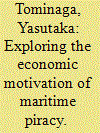

|
|
|
|
|
| Summary/Abstract |
This paper presents two hypotheses regarding the relationship between marine fisheries and maritime piracy. These hypotheses are based on the opportunity and willingness framework and describe how fish values and production can drive fishermen to engage in illegal activities, and the mechanisms that their capabilities and choices make available to them stipulate the forms that piracy takes when facing a declining fishing economy. The hypotheses are tested with the Maritime Piracy Data (MPD) using the negative binomial regression and the bivariate Poisson model. This study uses the instrumental variable approach to deal with endogeneity through two instruments: chlorophyll concentrations and temperature. The statistical analysis shows that unsophisticated piracy attacks are sensitive to fish production, but sophisticated attacks can be affected by both fish production and fish values and depend on the opportunity cost of existing fisheries and finding work in other industries.
|
|
|
|
|
|
|
|
|
|
|
|
|
|
|
|
| 8 |
ID:
186813


|
|
|
|
|
| Summary/Abstract |
Do more protesters on the streets make governments likely to grant their demands? Several studies link protest size and government concessions. Yet existing research has limitations: many studies suffer from potential endogeneity due to potential protesters joining protests when they anticipate that concessions are likely, causal mechanisms are often unclear, and many of the most rigorous event-level studies are limited to Western democracies. We reexamine this relationship in a non-Western sample using a novel instrumental variable approach, using Fridays as an instrument for exogenous variation in protest size in predominately Muslim countries. We perform two analyses: one using the NAVCO 3.0 dataset, and the second using the Mass Mobilization in Autocracies Dataset (MMAD). In both analyses exogenous variation in protest size negatively affects the likelihood of concessions. Larger protests are less likely to receive government concessions. We suggest these surprising results point to the importance of unanticipated protests that produce new information about regime stability to motivate government concessions.
|
|
|
|
|
|
|
|
|
|
|
|
|
|
|
|
| 9 |
ID:
170103
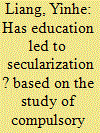

|
|
|
|
|
| Summary/Abstract |
Has education led to secularization? Using microdata from the Chinese General Social Survey (CGSS), we take the implementation of the Compulsory Education Law (CEL) in 1986 in China as the instrumental variables (IV) for personal educational attainment. We study the causal effect of education on personal religious beliefs and explore the potential mechanisms. The empirical results show that education can lead to secularization. More precisely, individual religious belief decreases by 1.5% with one additional year of personal education. In addition, the increase in regional urbanization significantly affects religious beliefs by replacing the insurance function of religion and reducing information acquisition costs. Moreover, there is an alternative relationship between religious activities and social activities, and women affected by the CEL experience a higher negative impact on religious beliefs than men.
|
|
|
|
|
|
|
|
|
|
|
|
|
|
|
|
| 10 |
ID:
187822
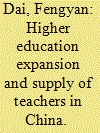

|
|
|
|
|
| Summary/Abstract |
We examine the teacher labour market in China using the 2005 mini-Census, in the context of the transformation of the world's largest education system. We first document a significant increase not only in quantity, but also in quality of teachers during 1990–2005. Instrumental Variables results based on the natural experiment of a substantial expansion of higher education in 1992/93 indicate a large positive causal effect of the expansion on supply of teachers. Consistent with differential opportunity costs across graduate occupations, the supply effect is more pronounced for women and those living in less developed regions. Further analyses of differential college premiums in earnings and non-pecuniary benefits between teaching and non-teaching occupations suggest that teacher recruitment has become more market-oriented and flexible, in attracting low to lower-middle ability college graduates into teaching in an increasingly decentralized and competitive graduate labour market.
|
|
|
|
|
|
|
|
|
|
|
|
|
|
|
|
| 11 |
ID:
150994


|
|
|
|
|
| Summary/Abstract |
An interesting stream of the civil conflict literature has identified an important subset of civil conflicts with disastrous consequences, that is, those that emerge as a consequence of shocks to renewable natural resources like land and water. This literature is, however, reliant on qualitative case studies when claiming a causal relationship leading from renewable resource shocks to conflict. In this article, we seek to advance the literature by drawing out the implications of a well-known formal model of the renewable resources–conflict relationship and then conducting rigorous statistical tests of its implications in the case of a serious ongoing civil conflict in India. We find that a one standard deviation decrease in our measure of renewable resources increases killings by nearly 60 percent over the long run.
|
|
|
|
|
|
|
|
|
|
|
|
|
|
|
|
| 12 |
ID:
161884
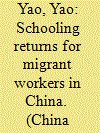

|
|
|
|
|
| Summary/Abstract |
We examine schooling returns for migrant workers in China based on the 2009 Rural-Urban Migration in China (RUMiC) survey. Using a novel instrumental variable (IV) set based on the institutional environment unique to rural China, we find the point estimates of returns to lie within the range of 7.8%–10.7% for each additional year of schooling. Whilst our estimates are slightly higher than those reported for this cohort of workers in the literature, they are significantly lower than those enjoyed urban dwellers. Furthermore, we identify a wider gap in schooling returns between male (14.7%) and female (8.5%) migrant workers than the comparable gap for urban dwellers. Our results provide another line of evidence supporting a segmented labor market in urban China and remain robust to different estimators and under various IV restrictions. We suggest that improving the education system in the rural areas and eliminating the gender gap among migrant workers represent the necessary steps for enhancing social harmony in the Chinese society.
|
|
|
|
|
|
|
|
|
|
|
|
|
|
|
|
| 13 |
ID:
133714
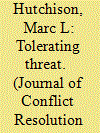

|
|
|
|
|
| Publication |
2014.
|
| Summary/Abstract |
Research on civil conflict focuses primarily on identifying underlying and proximate causes while leaving many questions of subsequent social consequences unanswered. Few studies have systematically examined how these conflicts affect public opinion, especially tolerance attitudes. Additionally, cross-national comparisons reveal significant differences in political tolerance levels but few explanations accounting for this variation. In this study, I bring together these disparate literatures and demonstrate the negative, independent effects of civil conflict on political tolerance levels across thirty-two countries. Examining data from the 1995-97 World Values Survey using several statistical techniques to ameliorate problems with endogeneity and multilevel data, I find that civil conflict dampens the public's willingness to extend basic civil liberties to nonconformist groups. By assessing the extent of domestic intolerance generated by various forms of civil conflict, this study makes important contributions to existing literatures and, more importantly, identify another obstacle to sustained peace in postconflict societies.
|
|
|
|
|
|
|
|
|
|
|
|
|
|
|
|
|
|
|
|
|